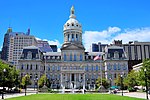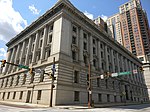Commerce Place (Baltimore)
1992 establishments in MarylandDowntown BaltimoreMaryland building and structure stubsOffice buildings completed in 1992Postmodern architecture in Maryland ... and 1 more
Skyscraper office buildings in Baltimore

Commerce Place is a high-rise in Baltimore, Maryland. The building rises 31 floors and 454 feet (138 m) in height, and stands as the fifth-tallest building in the city. The structure was completed in 1992. Commerce Place's project architect and lead designer was architect Geraldine Pontius of RTKL Associates, a Baltimore-based architectural and engineering firm; the structure is an example of Postmodern architecture. 23 of the building's 31 floors are used for commercial offices, while six are used for parking. The remaining two floors are used as retail space.
Excerpt from the Wikipedia article Commerce Place (Baltimore) (License: CC BY-SA 3.0, Authors, Images).Commerce Place (Baltimore)
South Street, Baltimore Downtown
Geographical coordinates (GPS) Address Website External links Nearby Places Show on map
Geographical coordinates (GPS)
| Latitude | Longitude |
|---|---|
| N 39.289333333333 ° | E -76.610444444444 ° |
Address
One South Street
South Street 1
21202 Baltimore, Downtown
Maryland, United States
Open on Google Maps










